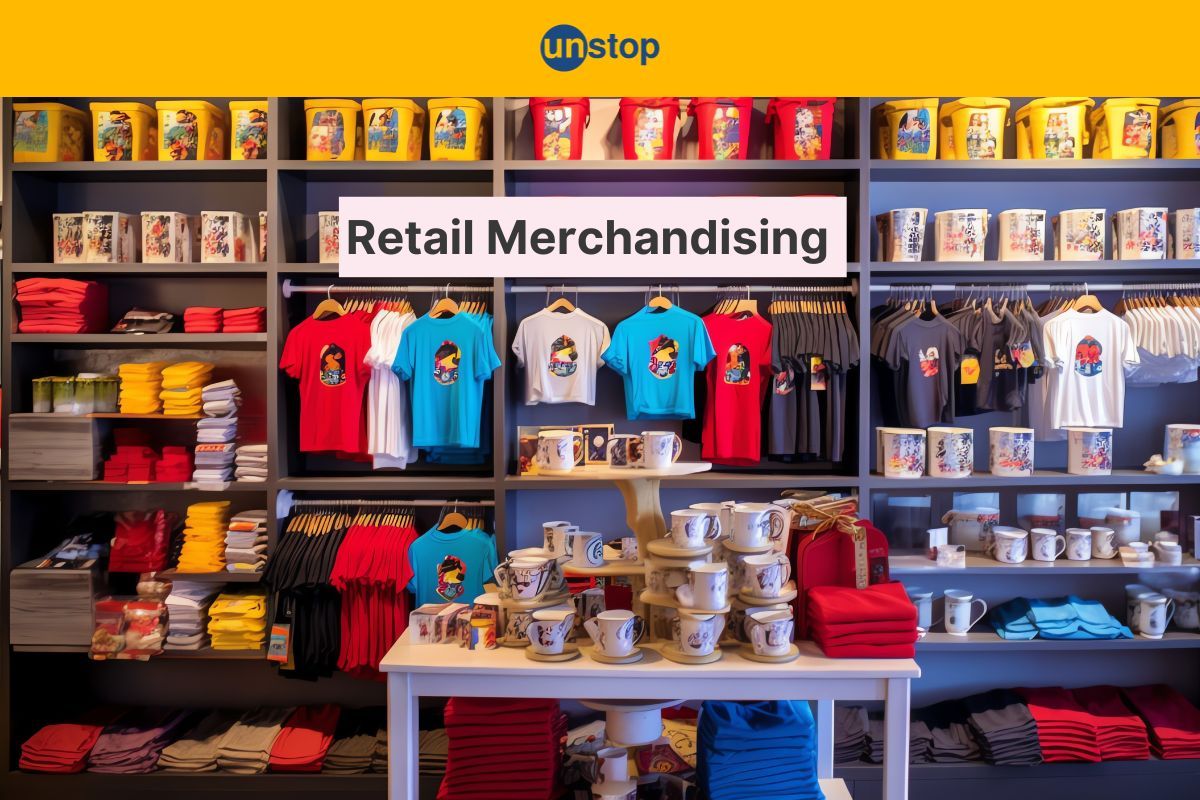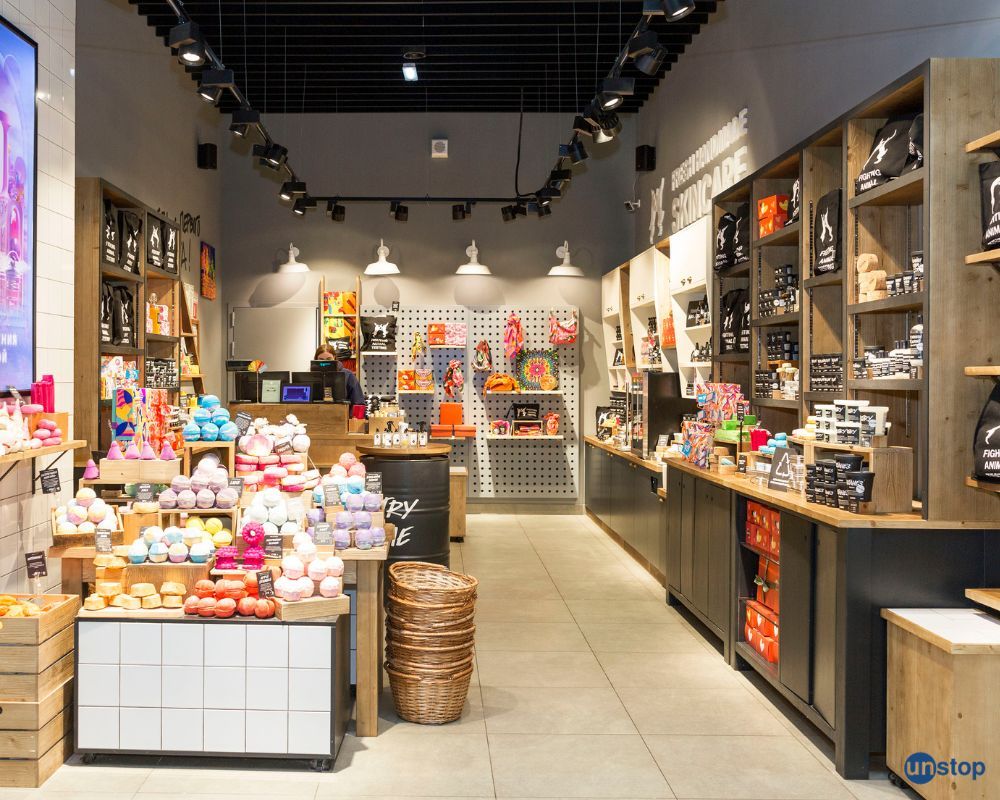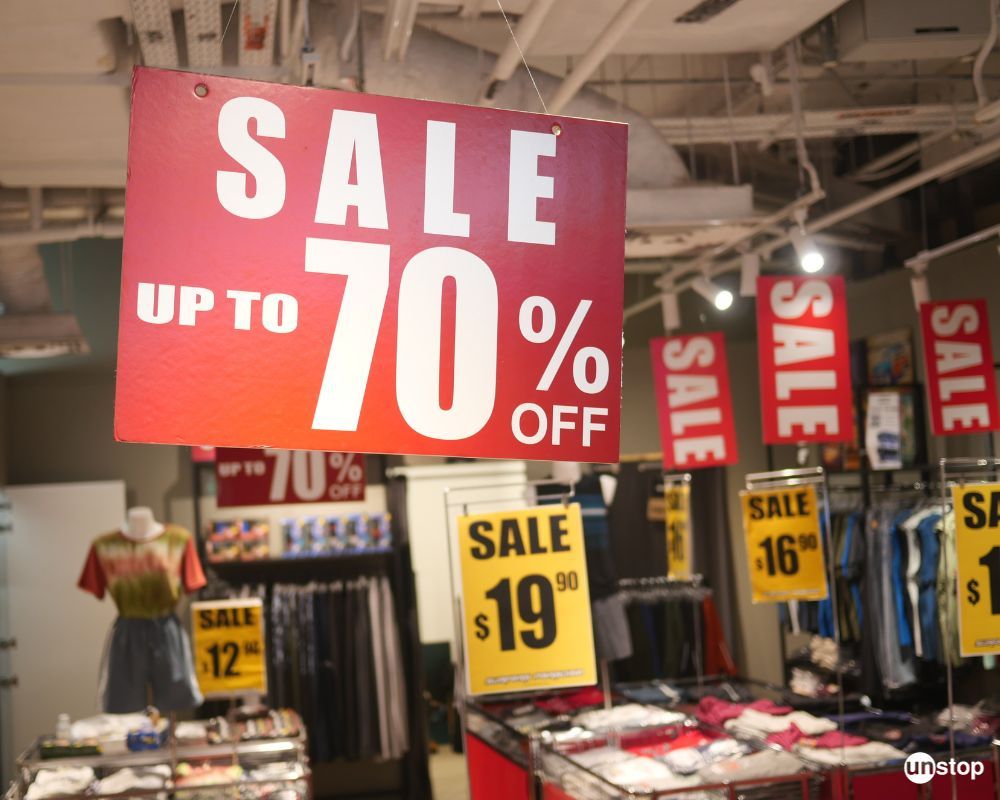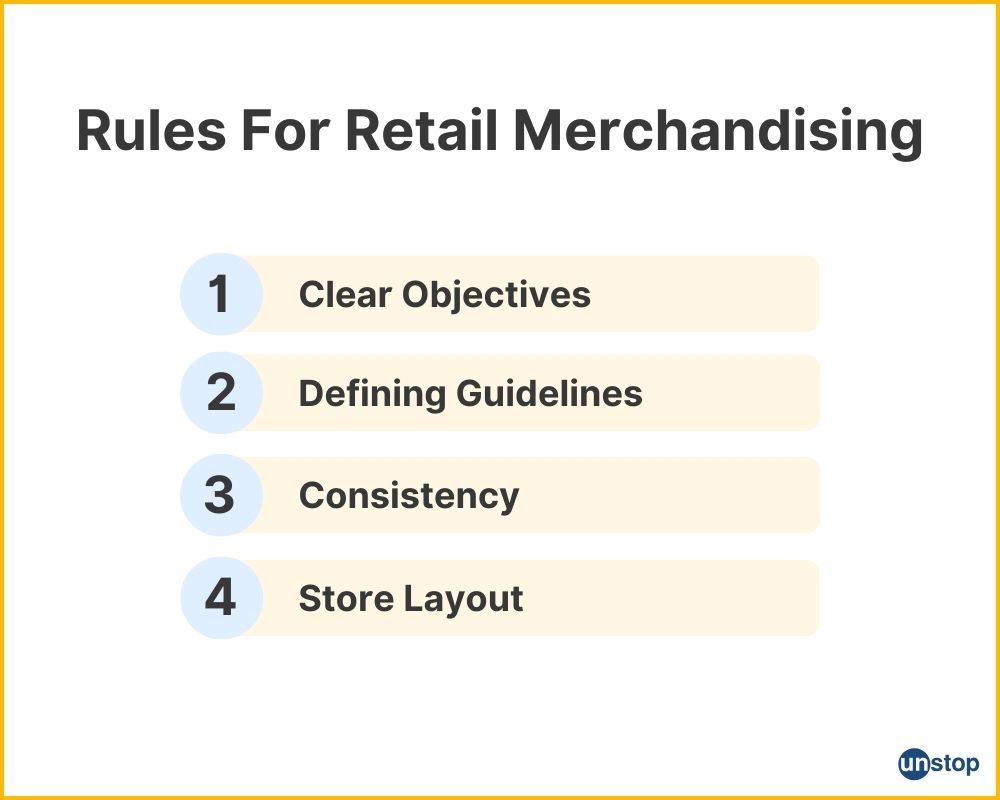- Importance & Relevance Of Retail Merchandising
- Establishing Rules For Retail Merchandising
- Best Practices For Effective Retail Merchandising
- Tips For A Clean & Well-Stocked Store
- Collaboration Between Company & Supplier
- Summary On Retail Merchandising
- Frequently Asked Questions (FAQs)
Retail Merchandising: The Ultimate Guide With Best Practices & Tips

Retail merchandising plays a pivotal role in the success of retail stores, encompassing various activities aimed at presenting products in an appealing and strategic manner. It involves the planning, execution, and management of visual displays, product placement, pricing strategies, and promotional efforts to maximize sales and enhance customer experience. Over time, retail merchandising practices have evolved to adapt to changing consumer preferences and market dynamics.
Key players involved in the retail merchandising process include merchandisers who develop plans for merchandise management, buyers who select products for sale based on market analysis, store managers responsible for implementing visual displays and layout designs, as well as marketing teams who coordinate promotions to attract customers.
Important Components Of Retail Merchandising
Retail merchandising has some important components that are essential for a retailer to incorporate into the retail marketing business.
Visual Merchandising
Visual merchandising plays an important part in the world of retail. It involves creating appealing displays and arranging products in a way that catches the customer's eye. The way a store looks can greatly impact how much customers perceive it as appealing. When a store is well-organized, clean, and visually appealing, customers are more likely to have a positive impression and feel inclined to make purchases.

Effective visual merchandising techniques can help create a pleasant shopping experience for customers. By strategically placing products, using attractive signage, and incorporating creative displays, retailers can draw attention to specific items or promotions. This not only increases the chances of making sales but also enhances brand positioning and customer loyalty.
Product Placement
Product placement is another vital aspect of retail merchandising. It involves positioning products in strategic locations within the store to maximize their visibility and increase sales potential. Placing popular or high-margin items at eye level or near checkout counters can encourage impulse purchases.
By inculcating the best consumer care services, retailers can determine the most effective product placement strategies for their target audience. For example, placing complementary products together or using cross-merchandising techniques can lead to increased sales by encouraging customers to purchase related items.
Pricing Strategies
Pricing strategies play a significant role in retail merchandising as they directly impact consumer behavior. Retailers need to carefully consider pricing decisions to attract customers while ensuring profitability. Offering competitive prices compared to competitors can attract price-conscious shoppers.

Discounts, promotions, and bundling options are effective pricing strategies that entice customers to make purchases. Limited-time offers or buy-one-get-one deals create a sense of urgency among consumers, driving them toward making immediate buying decisions.
Strategic Inventory Management
Strategic inventory management is crucial for successful retail merchandising. Maintaining the right balance of inventory helps ensure that products are available when customers want them, avoiding stockouts or overstock situations. This not only enhances customer satisfaction but also reduces costs associated with excess inventory or missed sales opportunities.

Retailers can utilize various inventory management techniques such as demand forecasting, just-in-time ordering, and efficient replenishment systems to optimize their inventory levels. By analyzing sales data and monitoring trends, retailers can make informed decisions about what products to stock and when to restock them.
Establishing Rules For Retail Merchandising
By establishing rules for retail merchandising, businesses can ensure consistency, enhance the shopping experience, and ultimately drive sales.

Clear Objectives: Setting clear objectives for visual merchandising efforts is crucial. This involves defining what you want to achieve through your visual displays and how they align with your overall business goals. By having specific objectives in mind, you can create visual merchandising strategies that effectively attract and engage customers.
Defining Guidelines: Another important aspect of retail merchandising is defining guidelines for product assortment and categorization. This involves determining which products to stock, how to group them, and how to present them in a visually appealing manner. By establishing clear guidelines, you can ensure consistency across all your stores and make it easier for customers to find what they are looking for.
Consistency: It is important to establish guidelines that dictate how prices should be set, how discounts or promotions should be offered, and how these strategies should be communicated to customers. By implementing consistent pricing and promotional strategies, you can build trust with your customers and avoid confusion or dissatisfaction.
Store Layout: The store layout plays a significant role in enhancing the shopping experience for customers. It is essential to create a cohesive store layout and navigation plan that guides customers through the store efficiently and optimizes their exposure to products. This involves strategically placing aisles, displays, and signage to facilitate easy movement and highlight key products or promotions.
Best Practices For Effective Retail Merchandising
For successful retail merchandising, retailers are expected to follow the best practices mentioned below:
Market Research
To excel in retail merchandising, it's of great importance to stay on top of the latest trends and understand customer preferences. Conducting regular market research allows retailers to gather valuable insights into what products are popular and what customers are looking for. By analyzing market data, such as sales figures and customer feedback, retailers can identify emerging trends and adjust their product assortment accordingly.
Data Analytics
Data analytics plays a vital role in optimizing product assortment and inventory levels. By leveraging data analytics tools, retailers can gain valuable insights into consumer behavior, demand patterns, and sales performance. This information helps them make informed decisions about which products to stock, how much inventory to hold, and when to replenish stock.
Cross-Selling & Upselling Techniques
One effective way for retailers to maximize revenue per customer visit is by implementing cross-selling and upselling techniques. Cross-selling involves suggesting complementary products that go well together with the item being purchased. Upselling refers to encouraging customers to buy a higher-priced or upgraded version of a product they are considering.
By incorporating these best practices into their retail merchandising strategies, businesses can enhance the shopping experience for their customers while maximizing revenue opportunities.
Tips For A Clean & Well-Stocked Store
To ensure a successful retail merchandising strategy, it is essential to maintain a clean and well-stocked store.
Efficient Stock Replenishment
Efficient stock replenishment processes are crucial for maintaining a well-stocked store. Retailers should establish clear protocols for restocking shelves promptly when items are running low. This includes monitoring inventory levels regularly and having a streamlined system in place to reorder products in a timely manner. By keeping track of sales data and customer demand patterns, retailers can forecast future needs accurately and avoid out-of-stock situations.
Regular Auditing
Regularly auditing inventory levels is another vital aspect of retail merchandising. By conducting routine checks on stock levels, retailers can identify any discrepancies or areas where adjustments need to be made. This helps prevent overstocking or understocking issues that can negatively impact sales and customer satisfaction. Utilizing technology such as barcode scanners or inventory management software can simplify the auditing process and provide real-time insights into product availability.
Cleanliness Standards
Maintaining cleanliness is key to creating an appealing shopping experience for customers. Retailers should establish cleanliness standards that outline expectations for store appearance, including dust-free shelves, organized displays, and spotless floors. Implementing regular cleaning schedules ensures that these standards are consistently met. Assign specific tasks to employees or consider hiring professional cleaning services to ensure thoroughness.
Storage Space
Proper organization of storage space is crucial for maintaining a well-stocked store. Retailers should maximize available resources by utilizing shelving units efficiently and categorizing products logically. This not only makes it easier for employees to locate items quickly but also enhances the overall shopping experience for customers. Consider implementing strategies such as color-coding, clear labeling, and utilizing storage bins or dividers to keep inventory organized.
By following these strategies, retailers can create a clean and well-stocked store that attracts customers and encourages them to make purchases. Remember that a clean and well-organized store not only enhances customer satisfaction but also improves employee productivity and boosts sales.
Collaboration Between Company & Supplier
Effective collaboration between a company and a supplier is vital for building a strong presence in the competitive market.
Relationship With Supplier
To ensure successful retail merchandising, it is crucial for companies to build strong relationships with their suppliers. By establishing a solid rapport, retailers can rely on their suppliers for the timely delivery of products. This helps maintain a well-stocked store and prevents any disruptions in the supply chain. Effective communication between retailers and suppliers is key to coordinating purchasing and restocking activities.
Data Sharing
Sharing sales data with suppliers plays a vital role in improving demand forecasting accuracy. By providing insights into customer preferences and buying patterns, retailers enable their suppliers to better understand market trends. Armed with this information, suppliers can adjust production levels accordingly, ensuring that the right products are available at the right time. This collaborative approach helps minimize stockouts or overstocking issues, leading to improved customer satisfaction.
Joint Marketing Initiatives
Collaboration between retailers and suppliers extends beyond product delivery. Joint marketing initiatives or promotions can be highly effective in driving sales and attracting customers. By pooling resources and expertise, both parties can create compelling campaigns that generate excitement and increase foot traffic to stores or online platforms. For example, a clothing retailer might collaborate with a fashion brand to launch an exclusive collection or offer special discounts during seasonal events.
Merchandising Planning
Merchandise planning requires close coordination between retailers and supply chain partners. Retailers need to communicate their inventory needs based on customer demand forecasts, while suppliers must align their production schedules accordingly. This synchronization ensures that there is sufficient stock available when customers want it most. Efficient merchandise planning minimizes excess inventory costs while maximizing sales opportunities.
Retail companies can achieve successful merchandising outcomes effectively by ensuring close-knit working collaboration with their supply chain partners. Building strong relationships, sharing sales data, collaborating on marketing initiatives, and coordinating merchandise planning are all essential components of this collaborative approach. Through effective communication and collaboration, retailers can ensure that they have the right products available at the right time to meet customer demands.
Summary On Retail Merchandising
By implementing effective retail merchandising practices, retailers can enhance their brand experience, attract customers, and ultimately drive sales. To maximize success through strategic retail merchandising, it is essential for retailers to establish clear rules and guidelines. Maintaining a clean and well-stocked store is equally important in driving customer satisfaction. By working closely with suppliers and manufacturers, retailers can gain insights into upcoming trends or new product launches. Overall, strategic retail merchandising has a significant impact on brand experience and business success.
Frequently Asked Questions (FAQs)
1. How can I create an effective product display?
Creating an effective product display involves careful consideration of various factors. Start by understanding your target audience and their preferences. Then, select products that complement each other and tell a cohesive story. Utilize visual merchandising techniques such as color coordination, focal points, and proper lighting to make the display visually appealing.
2. What are the benefits of collaborating with supply chain partners in retail merchandising?
Collaborating with supply chain partners allows retailers to gain valuable insights into upcoming trends and new product launches. This collaboration enables them to stay ahead of the competition by offering fresh merchandise that aligns with customer demands. It also fosters stronger relationships between retailers and suppliers, leading to more efficient inventory management and better pricing negotiations.
3. How often should I check my store's inventory?
Regular inventory checks are crucial for maintaining a well-stocked store and avoiding out-of-stock situations. The frequency of these checks depends on factors such as sales volume, seasonality, and product shelf life. However, conducting weekly or bi-weekly inventory counts is generally recommended to ensure accurate stock levels.
4. What role does pricing play in retail merchandising?
Pricing plays a critical role in retail merchandising as it directly impacts customer perception and purchase decisions. Retailers must consider factors such as production costs, competitor prices, market demand, and perceived value when setting prices for their merchandise. Striking the right balance between competitive pricing and profitability is essential for maximizing sales.
5. How can I enhance the brand experience through retail merchandising?
Enhancing brand experience through retail merchandising involves creating a consistent and memorable shopping environment that aligns with your brand values. This can be achieved by utilizing cohesive visual elements across stores, training staff to provide excellent customer service, incorporating interactive displays or technology where appropriate, and consistently delivering high-quality products.
Suggested reads:
- What is A Free Market: Meaning, Benefits And Disadvantages
- Retail Marketing: Types, Strategies And Examples Of Successful Market Players!
- The Difference Between Wholesale And Retail Explained (With Examples)
- Retail Pricing: Importance, Strategies, Examples & Tools
- Brand Identity Prism: A Guide To Build A Brand That Stands Out
Alekhya Chakrabarty is a father, a doodler, a trivia buff, a sports fanatic and a lifelong student of marketing. Alekhya is the VP of Marketing & Growth at Unstop, the engagement and hiring platform which connects students and graduates with opportunities. He has over a decade and a half of experience in driving revenue and building brands with the likes of Nestle, HUL and ITC. He is an alumnus of IMT Ghaziabad and in his last stint he was leading the marketing function at Sunstone, a higher education startup. Alekhya has been recognised as a ‘Top Voice’ on LinkedIn for Digital Marketing & Brand Management. He runs a marketing podcast titled East India Marketing Company to drive conversations around growth, content, culture and commerce.
Login to continue reading
And access exclusive content, personalized recommendations, and career-boosting opportunities.
Subscribe
to our newsletter
















Comments
Add comment